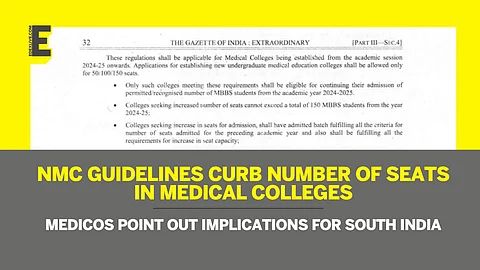

Recent guidelines by the National Medical Commission (NMC) state that starting from the academic year 2024-25, new medical colleges cannot offer more than 150 seats to students.
This notification, released on August 16, dictates guidelines for the establishment of new medical institutions and colleges and aims to set a minimum requirement for seats, staff, and equipment in these institutions.
The objective of these regulations is to prescribe for a medical college and Medical Institution approved for admissions of MBBS students annually, the minimum requirements of accommodation in the college and its associated teaching hospitals, staff (teaching and technical) and equipment in the college departments and hospitals,” the Gazette notification reads.
The notification further says that to be eligible to apply for the establishment of new medical colleges, the number of seats should be 50, 100, or 150. In addition, the ratio of the number of seats and the population of the state or union territory must be 100 seats to 10 lakh people.
Contradictory move
According to a few doctors, this move exposes a contradictory thought process in the way the NMC operates.
Elaborating on this, Dr Keerthy Varman, President of the Tamil Nadu Medical Students’ Association (TNMSA) says that instead of placing limits on the number of seats in new colleges, the NMC should have first regularised the number of new medical colleges being set up. “After the NMC was established in 2019, it has become very easy for anyone to set up a medical college. In Chennai alone, 12 new medical colleges have emerged in the last few years. On one hand, the NMC let the number of medical colleges increase, and on the other hand, it is limiting the seats. It is creating solutions for the problems it created,” he claims.
Further, the medico adds that this move interferes with the healthcare systems of the states and tries to impose a single norm for all states in India. “How fair is imposing one single rule for all states? The NCM must let the states control their healthcare system,” Dr Varman adds. He says that NMC must focus on increasing the number of vacancies for medical graduates instead of putting a cap on the number of seats.
More needs to be done to ensure quality healthcare
In Telangana, the ratio of 100 seats for a 10 lakh population is almost met, says Dr P Karunakar, Chairman PG Dental Board of Studies and Senate Member of Kaloji Narayana Rao University of Health Sciences, Warangal.
“Most medical colleges and institutes in Telangana — be it All India Institute of Medical Sciences (AIIMS), Nizam Institute of Medical Sciences (NIMS), Krishna Institute of Medical Sciences, Osmania Medical College, or Gandhi Medical College — are concentrated in the Hyderabad, Secunderabad, and Ranga Reddy Districts. Establishing two or three more medical colleges in more remote districts of Telangana would ensure that the ratio is met completely,” Dr Karunakar explains.
However, for these institutions, there must also be a ceiling to the number of seats that can be increased at one point.
He elaborates, “Every three or four years, medical colleges increase the number of seats they offer. They increase them to 200 seats or even 300. In such a scenario, the number of students goes up and the quality of education is affected. For example, a practical class at an operating table would be more efficient if there were five students per table — not 20. It is simple logic; the quality of food decreases when there are more people to feed with limited resources. The same is the case with the number of students and quality of education.”
In addition, the new hospitals in these remote districts should also have super-speciality centres, to provide good quality healthcare to the people of those districts and the surrounding ones, he says.
“People from the most remote districts of Telangana need to travel all the way to Hyderabad, Ranga Reddy, or even Warangal for treatment. In addition to the medical expenses, they also bear the brunt of travel expenses,” he says. Instead, he adds, having super-speciality centres in these districts would enable them to receive quality healthcare while travelling shorter distances.
